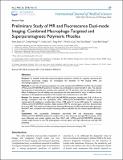| dc.contributor.author | Li, Wen-Juan | en_US |
| dc.contributor.author | Wang, Yong | en_US |
| dc.contributor.author | Liu, Yulin | en_US |
| dc.contributor.author | Wu, Teng | en_US |
| dc.contributor.author | Cai, Wen-Li | en_US |
| dc.contributor.author | Shuai, Xin-Tao | en_US |
| dc.contributor.author | Hong, Guo-Bin | en_US |
| dc.date.accessioned | 2018-02-26T20:42:28Z | |
| dc.date.issued | 2018 | en_US |
| dc.identifier.citation | Li, Wen-Juan, Yong Wang, Yulin Liu, Teng Wu, Wen-Li Cai, Xin-Tao Shuai, and Guo-Bin Hong. 2018. “Preliminary Study of MR and Fluorescence Dual-mode Imaging: Combined Macrophage-Targeted and Superparamagnetic Polymeric Micelles.” International Journal of Medical Sciences 15 (2): 129-141. doi:10.7150/ijms.21610. http://dx.doi.org/10.7150/ijms.21610. | en |
| dc.identifier.issn | | en |
| dc.identifier.uri | http://nrs.harvard.edu/urn-3:HUL.InstRepos:34868942 | |
| dc.description.abstract | Purpose: To establish small-sized superparamagnetic polymeric micelles for magnetic resonance and fluorescent dual-modal imaging, we investigated the feasibility of MR imaging (MRI) and macrophage-targeted in vitro. Methods: A new class of superparamagnetic iron oxide nanoparticles (SPIONs) and Nile red-co-loaded mPEG-Lys3-CA4-NR/SPION polymeric micelles was synthesized to label Raw264.7 cells. The physical characteristics of the polymeric micelles were assessed, the T2 relaxation rate was calculated, and the effect of labeling on the cell viability and cytotoxicity was also determined in vitro. In addition, further evaluation of the application potential of the micelles was conducted via in vitro MRI. Results: The diameter of the mPEG-Lys3-CA4-NR/SPION polymeric micelles was 33.8 ± 5.8 nm on average. Compared with the hydrophilic SPIO, mPEG-Lys3-CA4-NR/SPION micelles increased transversely (r2), leading to a notably high r2 from 1.908 µg/mL-1S-1 up to 5.032 µg/mL-1S-1, making the mPEG-Lys3-CA4-NR/SPION micelles a highly sensitive MRI T2 contrast agent, as further demonstrated by in vitro MRI. The results of Confocal Laser Scanning Microscopy (CLSM) and Prussian blue staining of Raw264.7 after incubation with micelle-containing medium indicated that the cellular uptake efficiency is high. Conclusion: We successfully synthesized dual-modal MR and fluorescence imaging mPEG-Lys3-CA4-NR/SPION polymeric micelles with an ultra-small size and high MRI sensitivity, which were effectively and quickly uptaken into Raw 264.7 cells. mPEG-Lys3-CA4-NR/SPION polymeric micelles might become a new MR lymphography contrast agent, with high effectiveness and high MRI sensitivity. | en |
| dc.language.iso | en_US | en |
| dc.publisher | Ivyspring International Publisher | en |
| dc.relation.isversionof | doi:10.7150/ijms.21610 | en |
| dc.relation.hasversion | http://www.ncbi.nlm.nih.gov/pmc/articles/PMC5765726/pdf/ | en |
| dash.license | LAA | en_US |
| dc.subject | SPIONs | en |
| dc.subject | polymeric micelles | en |
| dc.subject | macrophage-targeted | en |
| dc.subject | fluorescence imaging | en |
| dc.subject | MRI. | en |
| dc.title | Preliminary Study of MR and Fluorescence Dual-mode Imaging: Combined Macrophage-Targeted and Superparamagnetic Polymeric Micelles | en |
| dc.type | Journal Article | en_US |
| dc.description.version | Version of Record | en |
| dc.relation.journal | International Journal of Medical Sciences | en |
| dc.date.available | 2018-02-26T20:42:28Z | |
| dc.identifier.doi | 10.7150/ijms.21610 | * |


